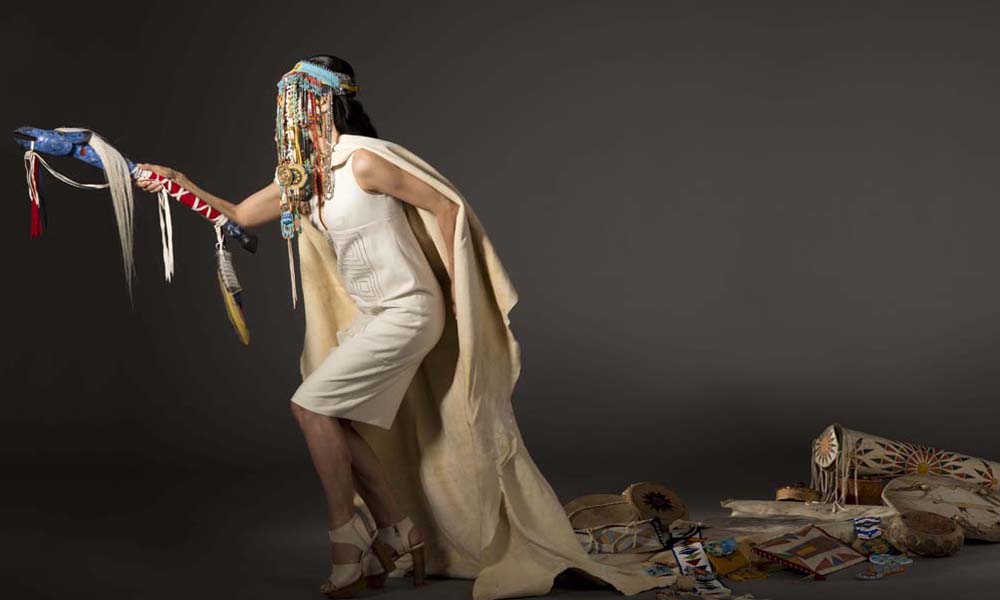Vancouver-based artist Dana Claxton has spent her entire career thinking about how to bring Lakota ideas of spirituality and culture into contemporary art. Her practice has ranged from an early film in which she yells repeatedly “I want to know why!” to recent large-scale prints of redacted FBI documents related to the American Indian Movement.
This week, she opens a new body of work at the Audain Gallery in Vancouver titled “Made to Be Ready”—a new term, she says, that aims to locate art history’s dehumanization of Indigenous people. In a phone conversation with Canadian Art, Claxton reflected on six ways this can happen.
1. Redefine how we think and speak of Indigenous cultural belongings—particularly in anthropological, museological and art circles.
The “made-to-be-ready” term Claxton has developed is a more accurate alternative to terms like “object,” or “artifact,” or other ways anthropology and museology and art have described everything from rattles to shields to masks and beyond, says Claxton.
A “made-to-be-ready” is emphatically “not an object,” Claxton says. “It’s something that has a functional purpose. I’m thinking here of when [Kwakwaka’wakw
art historian] Gloria Cranmer Webster commented that ‘There is no word for art in our language.’”
For instance, Claxton says, masks are “made to be ready to be danced,” while “rattles are made to be ready to be heard and moved whether ceremonially or socially. War shields are made to be ready to protect. They’re not a static object that’s to hang on the wall—but many of these things have been turned into [that].”
2. Reconsider the original context in which Indigenous cultural belongings were made and used.
“If we’re saying, ‘okay, they’re not art,’ they become several things, right?” Claxton says. “It all depends what context they are in, but the original purpose of these cultural belongings were outside of market, outside of connoisseurship, outside of collecting, outside of exhibition.”
3. Recognize that art has played into the structural dehumanization of Indigenous people.
“The structural dehumanization of Indian people has been significant in Canada and in North America, and art has played a role in that,” Claxton says.
This dehumanization has found many forms: from the mislabeling or misinterpretation of cultural belongings in museums—“you know, wrong tribal identity”—to “being deemed a primitive culture” in early scholarly research, to outright outlawing of Indigenous cultural forms.
“Think of the criminilazation of culture,” says Claxton, “the burning of masks, the outlawing of dancing. Can you imagine the dance is outlawed and everything that’s adorned and made to go with that specifically?” She offers the Sun Dance and the Potlatch as just two examples.
“So those [ceremonial] belongings which then stopped being made contained an aesthetic,” Claxton says, and she argues that the aesthetic signifiers were structurally dehumanized through anthropology and ethnology as well as art history.
4. Remember how complex the process of “rehumanization” is—as complex as the history that has dehumanized people.
“Once something has been attempted, and I want to say attempted, to be destroyed, you have to go through all the rubble and all of that destruction and it’s complex,” Claxton says, to recuperate.
Claxton references, as an example of that complexity, the “multiple gazes on the Indigenous body…. There’s the colonial gaze and then the settler gaze and then the Canadian gaze and then the newcomer gaze—and I’m using ‘newcomer’ as ‘after the Canadian flag.’ These multiple layers of the gaze are heaped upon Indigenous bodies.”
“Even when I started making art I was also trying to think about what’s gone on here; what’s gone on here in my own family; and what’s gone on here in this country systemically in terms of Indigenous history,” Claxton says. “As you know it is complex, and it haunts us and it still informs social relations, both healthy ones and ones that are embedded in stereotype.”
5. Recall that beauty, even though it is fraught, can still be a useful tool.
Claxton says that in the process of making the works in “Made to be Ready,” she was “wanting to show Indigenous beauty, you know? Nobody owns beauty.”
Regarding objections to this orientation, she notes, “I’ve been asked about that: ‘How can you use the word beauty, it only belongs to one interpretation? But I’m into the gorgeous. What is the gorgeous, and the beauty of Indigenous culture? I’m thinking of those things as well.”
6. Rework stereotypes as needed.
“I locate the stereotype, and work with it as well,” Claxton says. One of her works in “Made to Be Ready,” an image of a woman holding a crystal buffalo skull—the skull is made by Kevin Mackenzie—speaks to certain stereotyped kitsch: “You know, all those Indian dollies at the airport: how could we still have those? It’s so interesting, especially in Winnipeg, and even in Vancouver, all these brown little dollies.”
Among these dolls she once saw “one of an Indian lady holding a skull up to the sky”—something that spelled out “the cliché and the stereotype, but yet at the same time, within Sun Dance culture, some of those actions we actually do.”
“Dana Claxton: Made to Be Ready” opens January 14 at the Audain Gallery in Vancouver, and continues until March 12, 2016.
This article was updated on May 18, 2016. The original copy did not mention that the crystal buffalo skull was made by Kevin Mackenzie.









